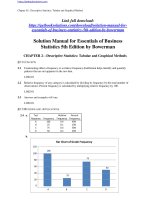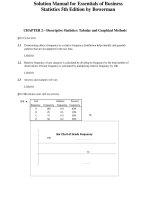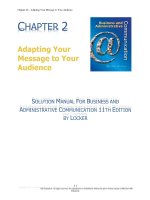Solution manual for organic chemistry mechanistic patterns 1st edition by ogilvie
Bạn đang xem bản rút gọn của tài liệu. Xem và tải ngay bản đầy đủ của tài liệu tại đây (1.79 MB, 27 trang )
Solution Manual for Organic Chemistry Mechanistic Patterns 1st Edition by Ogilvie
Full file at />
Chapter 1
Carbon and Its Compounds
CHECKPOINT PROBLEMS
Practice Problem 1.1
a) S — 1s22s22p63s23p4
b) Cl — 1s22s22p63s23p5
c) Na+ — 1s22s22p6
Full file at />
Solution Manual for Organic Chemistry Mechanistic Patterns 1st Edition by Ogilvie
Full file at />Practice Problem 1.2
a) Count valence electrons.
Build a basic bonding framework and account for electrons used.
Add remaining electrons and check for formal charges.
The molecule has a lone pair on the nitrogen. All other electrons are bonding electrons.
b) Count valence electrons.
Build a basic bonding framework and account for electrons used.
1-2
Full file at />
Copyright © 2018 Nelson Education Limited
Solution Manual for Organic Chemistry Mechanistic Patterns 1st Edition by Ogilvie
Full file at />Add remaining electrons and check for formal charges.
There are formal charges on the S and O atoms. They can be removed by making an
additional bond between O and S.
The molecule has a lone pair on the sulfur and two lone pairs on oxygen. All other electrons
are bonding electrons.
c) Count valence electrons.
CH3CH2CN (nitrogen is connected to one carbon only)
3 carbons (group 4)
5 hydrogens (group 1)
1 nitrogen (group 5)
3 X 4 = 12
5X1= 5
1X5= 5
22 valence e-
Build a basic bonding framework and account for electrons used.
H H
H C C C N
H H
8 bonds = 16 bonding e 22 valence e - – 16 bonding e - = 6 non-bonded e -
Copyright © 2018 Nelson Education Limited
Full file at />
1-3
Solution Manual for Organic Chemistry Mechanistic Patterns 1st Edition by Ogilvie
Full file at />Add remaining electrons and check for formal charges.
The formal charges on C and N show the carbon needs more electrons and the N has too
many. Forming two more bonds between C and N alleviates this problem.
The molecule has a lone pair on the nitrogen. All other electrons are bonding electrons.
d) Count valence electrons.
Build a basic bonding framework and account for electrons used.
Add remaining electrons and check for formal charges.
The oxygen atom has three lone pairs and a positive charge. All other electrons are bonding
electrons.
1-4
Full file at />
Copyright © 2018 Nelson Education Limited
Solution Manual for Organic Chemistry Mechanistic Patterns 1st Edition by Ogilvie
Full file at />e) Count valence electrons.
Build a basic bonding framework and account for electrons used.
Add remaining electrons and check for formal charges.
The ion has a formal positive charge on the nitrogen. All electrons are bonding electrons.
f)
Count valence electrons.
Build a basic bonding framework and account for electrons used.
Copyright © 2018 Nelson Education Limited
Full file at />
1-5
Solution Manual for Organic Chemistry Mechanistic Patterns 1st Edition by Ogilvie
Full file at />Add remaining electrons and check for formal charges.
There are formal charges on the sulfur (+1) and two of the oxygens (-1). These can be
reduced by forming a double bond between sulfur and either of the oxygen atoms carrying a
formal charge.
The ion has seven lone pairs on oxygen atoms and one lone pair on sulfur. All other
electrons are bonding electrons. One oxygen has a formal negative charge.
g) Count valence electrons.
Build a basic bonding framework and account for electrons used.
Add remaining electrons (on oxygen first) and check for formal charges.
1-6
Full file at />
Copyright © 2018 Nelson Education Limited
Solution Manual for Organic Chemistry Mechanistic Patterns 1st Edition by Ogilvie
Full file at />There are formal charges on the sulfur (+3) and two of the oxygens (-1). These can be
reduced by forming double bonds between sulfur and both charged oxygen atoms. This
expands the octet of the sulfur but, since it is a third-row element, this is allowed.
O
H O S O
O
O S O
OR
H
The final ion has six lone pairs on oxygen atoms. The sulfur has a formal positive charge.
All other electrons are bonding electrons.
Practice Problem 1.3
a)
b) Lewis Structure
H O H
H C C C H
H
H
reduce formal charges
H O H
H C C C H
H
H
valence e- = 9 (9H) + 12 (3C) + 7 (1Cl) = 28 e 28 valence e - – 18 bonding e - = 6 non-bonded e -
dO
H3C C CH 3
d+
dipole
c)
Copyright © 2018 Nelson Education Limited
Full file at />
1-7
Solution Manual for Organic Chemistry Mechanistic Patterns 1st Edition by Ogilvie
Full file at />d)
d+
d- H H H H H
H O C C C C C O dd+
d+
H H H H
H–O bond dipole
C–O bond dipole
C=O bond dipole
Practice Problem 1.4
In the solutions, “BG” is used as an abbreviation for “bond group” and “LP” is used as an
abbreviation for “lone pair.”
a)
b)
c)
1-8
Full file at />
Copyright © 2018 Nelson Education Limited
Solution Manual for Organic Chemistry Mechanistic Patterns 1st Edition by Ogilvie
Full file at />Integrate the Skill 1.5
All carbons have four bonds and so will not have lone pairs. Lone pairs are added to the nitrogen
atoms according to the formal charges indicated. “BP” refers to shared pairs of electrons in
bonds between atoms where each atom formally has one of the electrons.
formal charge of –1 = 6 valence e = 2 (2BP) + 4 (2LP)
H
H
N
C H
H C
C
C H
H
N
H
formal charge of 0 = 5 valence e = 3 (3BP) + 2 (1LP)
The geometry of the atoms can then be established for all of the atoms.
Practice Problem 1.6
a)
H
H
H
C
2 BG + 2 LP \ bent
C
O
3 BG \
trigonal planar
C
C
H
H
b)
H
4 BG \ tetrahedral
H
H
H
C
C
sp2
O
C
H
sp3
C
H
H
Copyright © 2018 Nelson Education Limited
Full file at />
1-9
Solution Manual for Organic Chemistry Mechanistic Patterns 1st Edition by Ogilvie
Full file at />Integrate the Skill 1.7
a) Accounting for all of the electrons leaves four non-bonded electrons to add as lone pairs.
These are added to the oxygen first (most electronegative), leaving the carbon with a formal
positive charge.
b) Electron geometry:
c) Hybridization:
d) The charged carbon is not saturated, so a second bond to the oxygen can be formed. This
moves the formal charge to the oxygen atom.
H
H C O C H
H
H
H
H C O C H
H
H
1-10
Full file at />
Copyright © 2018 Nelson Education Limited
Solution Manual for Organic Chemistry Mechanistic Patterns 1st Edition by Ogilvie
Full file at />This leads to the following geometries for the new structure.
The corresponding hybridizations would then be
trigonal planar \ sp 2
H
H
H C O C
H
H
trigonal planar \ sp 2
tetrahedral \ sp 3
Practice Problem 1.8
a)
b)
c)
d)
O
H3C
O
NH2
H3C
O
NH2
Copyright © 2018 Nelson Education Limited
Full file at />
H3C
NH2
1-11
Solution Manual for Organic Chemistry Mechanistic Patterns 1st Edition by Ogilvie
Full file at />Integrate the Skill 1.9
Drawing the basic structure leaves a formal positive charge on the carbon atom and lone pairs on
each nitrogen atom.
Three more resonance forms can be produced by forming a double bond between each of the
nitrogen atoms and the central carbon atom. This leaves the formal charge on a nitrogen atom for
each of these new forms.
NH2
H2N
NH2
NH2
H2N
NH2
NH2
H2N
NH2
NH2
H2N
NH2
Practice Problem 1.10
a)
i)
ii)
b)
i)
ii)
c)
i)
ii)
d)
i)
ii)
1-12
Full file at />
Copyright © 2018 Nelson Education Limited
Solution Manual for Organic Chemistry Mechanistic Patterns 1st Edition by Ogilvie
Full file at />Integrate the Skill 1.11
The formal charge can be on the carbon or the oxygen. Both are acceptable Lewis structures.
Copyright © 2018 Nelson Education Limited
Full file at />
1-13
Solution Manual for Organic Chemistry Mechanistic Patterns 1st Edition by Ogilvie
Full file at />PROBLEMS
1.12
a)
b) The ground-state configuration is 1s22s22p1.
c)
Boron has four valence orbitals.
1.13
a) Hydrogen has one electron. In the ground state, it is contained in the 1s orbital. An electron
in the 2s orbital would have to be an excited state of the hydrogen atom.
b) Carbon has six electrons. Its electron configuration is 1s22s22p2. Therefore, the valence
electrons are in 2s and 2p orbitals. The 1s orbital is a core orbital.
1.14
a) The degenerate sets of atomic orbitals are indicated below.
1-14
Full file at />
Copyright © 2018 Nelson Education Limited
Solution Manual for Organic Chemistry Mechanistic Patterns 1st Edition by Ogilvie
Full file at />b) The 3p orbitals are lower in energy than the 3d.
c) The 3s orbital should be spherical, as are the 1s and 2s orbitals, but larger.
d) The 3p orbitals should be similar in shape to the 2p orbitals, but larger.
e) The ground-state electron configuration of silicon:
f) The ground-state electron configuration of silicon is 1s22s22p63s23s23p2.
g) Silicon has four valence electrons (3s23p2), the same as carbon. The Lewis dot diagram of
silicon would therefore be
1.15
a)
e)
b)
f)
c)
d)
Copyright © 2018 Nelson Education Limited
Full file at />
g)
1-15
Solution Manual for Organic Chemistry Mechanistic Patterns 1st Edition by Ogilvie
Full file at />h)
i)
An intermediate structure is useful in determining the final structure.
j)
l)
k)
1.16
Bond pairs are shown as dashes (–), as indicated.
1.17
a) A molecule of formula C2H5N having no formal charge on any atom:
b) A cation of formula C2H8N+:
1-16
Full file at />
Copyright © 2018 Nelson Education Limited
Solution Manual for Organic Chemistry Mechanistic Patterns 1st Edition by Ogilvie
Full file at />c)
An anion of formula C2F3O− having a C=O bond:
d) Two neutral molecules of formula C2H3N, both having a C–N triple bond:
1.18
a) (CH3)2CHCH2NH2
c) Cl 2 CHCH 2 CONHCH 3
b) HO(CH2)2CH=C(CH2CH3)2
d) NH(CH2CN)2
1.19
a)
d)
b)
e)
c)
f)
Copyright © 2018 Nelson Education Limited
Full file at />
1-17
Solution Manual for Organic Chemistry Mechanistic Patterns 1st Edition by Ogilvie
Full file at />1.20
a)
c)
b)
d)
1.21
Electronegativities are provided in Figure 1.6.
a) The N–H bond would be more polar due to the larger electronegativity difference between
N(3.0) and H(2.2) than between B(2.0) and H(2.2). The distinction between them is that the
N–H bond is polarized toward the nitrogen, while the B–H bond is polarized toward the
hydrogen.
b) i)
c)
ii)
iii)
iv)
i)
iii)
ii)
iv)
1-18
Full file at />
Copyright © 2018 Nelson Education Limited
Solution Manual for Organic Chemistry Mechanistic Patterns 1st Edition by Ogilvie
Full file at />1.22
a)
c)
b)
d)
1.23
a)
c)
b)
d)
1.24
a)
Copyright © 2018 Nelson Education Limited
Full file at />
b)
1-19
Solution Manual for Organic Chemistry Mechanistic Patterns 1st Edition by Ogilvie
Full file at />c)
e)
d)
1.25
In each diagram, the hybridization, electron pair geometry, and bond geometry for the nonhydrogen atoms are indicated.
a)
b)
c)
1-20
Full file at />
Copyright © 2018 Nelson Education Limited
Solution Manual for Organic Chemistry Mechanistic Patterns 1st Edition by Ogilvie
Full file at />d)
e)
1.26
a)
b)
c)
d)
Copyright © 2018 Nelson Education Limited
Full file at />
1-21
Solution Manual for Organic Chemistry Mechanistic Patterns 1st Edition by Ogilvie
Full file at />1.27
a)
e)
b)
f)
c)
g)
d)
1.28
a)
d)
b)
e)
c)
f)
1-22
Full file at />
Copyright © 2018 Nelson Education Limited
Solution Manual for Organic Chemistry Mechanistic Patterns 1st Edition by Ogilvie
Full file at />g)
i)
h)
j)
1.29
a)
d)
b)
e)
c)
f)
1.30
a) (CH3)CCHCH2CH2CH(CH3)CHO
d) CH3CH2OCH2CH2N(CH3)
COCH(CH3)2
b) C6H5COOH
e) CH3CH2CH2CH2CN
c) (CH3)2CHCHCHCOCHBrCH2OCHO
f) CH3CH2CCCHCHCH2OH
Copyright © 2018 Nelson Education Limited
Full file at />
1-23
Solution Manual for Organic Chemistry Mechanistic Patterns 1st Edition by Ogilvie
Full file at />1.31
a)
c)
b)
d)
1.32
a)
b) [CH3OCCHCHCHBrCHCH]
A
B
Note the use of the bracket drawn above this condensed structure to indicate the ring in the
molecule. The bracket denotes the connection between carbon atoms A and B, which are
actually beside each other in the molecule but are located at opposite ends of its condensed
structure. All six carbon atoms in the ring are, therefore, in the bracket.
c)
d) CH3CH2CON(CH3)2
1.33
a)
c)
b)
d)
1-24
Full file at />
Copyright © 2018 Nelson Education Limited
Solution Manual for Organic Chemistry Mechanistic Patterns 1st Edition by Ogilvie
Full file at />1.34
a)
c)
b)
d)
1.35
a) The geometry at each non-H atom in the above molecule appears below. Carbons are
numbered in the diagram for clarity.
b) Hybridizations for each non-H atom:
Bond descriptions:
Bond 1 – C sp3- C sp2 -bond
Bond 4 – C sp3- C sp2 -bond
Bond 2 – C sp2- C sp2 -bond
+ C p- C p -bond
Bond 5 – C sp2- C sp -bond
Bond 3 – C sp - C sp -bond
3
3
Copyright © 2018 Nelson Education Limited
Full file at />
Bond 6 – O sp2- H s -bond
1-25









